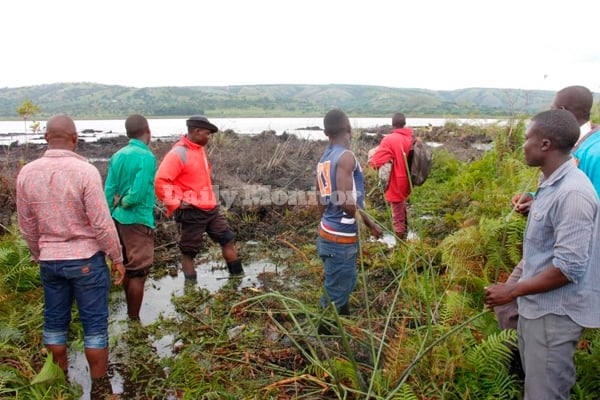Prime
Fishermen wake up to a drying Lake Kijanebarola

Fishermen at Kalunga Landing Site in Rakai District where Lake Kijanebarola receded by about a kilometre. PHOTO | AMBROSE MUSASIZI
What you need to know:
- The lakes. Lake Kijanebarola is a major water source for communities in Lyantonde, Rakai and Isingiro districts. But with the papyrus eating up the lake shores, it is getting increasingly difficult for families to make a living through agriculture, fishing and livestock farming. Its tributaries connect to Lake Kacheera and River Kagera, which pours its water into Lake Victoria.
Lake Kijanebarola, loosely translated as ‘‘it came while we were seeing”, could have as well gone back while the residents were not seeing.
This emerged last week after fishermen and residents of Kyarulangira Sub-county and Ddyango Town Council in Rakai District woke up to the shock of their lives after the water body had receded at Kalunga Landing Site.
The water at the landing site has receded by a kilometre, making fishing and travel on the lake difficult.
Mr Elisa Wangi Ssemanda, the chairperson of Ddyango Town Council, said the receding of the lake has greatly affected the fishermen who earn a living from the water body .
“This landing site has been a source of income to many people in the neighbouring villages as well as a source of food, but the water has dried up,” he said during an interview on Tuesday.
“We are planning to meet the fishermen and advise them to engage in other businesses since they can no longer get fish,” he said.
A total of 50 fishermen are affected, according to Mr Ssemanda.
Surprisingly, the receding of the lake has occurred at a time torrential rains are pounding the area.
Other landing sites on the same lake such as Lwanga, Kanagisa and Kabakyala are submerged.
Lake Kijanebarola covers several areas in Rakai District such as Kyarurangira, Ddyango Town Council, Ddwaniro, Kagamba, Kibaale, Kibanda, Lwamaggwa, Kacheera and Rakai Town Council.
The lake borders Isingiro District where some residents use it to water livestock.
Mr Bernard Wangi said he has been a fisherman all his life and switching to another occupation will be challenging.
“I have grown up at this fishing site and the only job and source of income I know is fishing, just like my other friends. The only option we have now is to relocate to other nearby landing sites so that we can continue with our fishing activity,” he explained.
Mr Wangi added that this is not the first time the lake is receding. “We experienced a similar situation in 1997 and it took us a full year for the lake to fill up with water. We are still hopeful that the receding waters will come back,” he added.
Mr Samson Kyewalabye, a resident of Rwabaganda Village, said: “We used to see boats bobbing up and down on the water, but this has ceased since last week. All the fishermen have since tied up their boats because they can no longer move.”
Mr Richard Kalungi Bikande, the Rakai District environment officer, blamed this situation on what he described as underground forces.
“It is a result of underground forces that push water to move, but it usually takes some few months to fill up,” he said. He, however, warned residents not to occupy the area where water has dried up. “Some [residents] may attempt to turn the dried up area into plantations, let them not dare do it; lake water will unexpectedly come back any time,”
Mr Dickson Ssebyala, the minister for culture in Kooki Cultural Institution, said Lake Kijanebarola is one of the tourism attractions people in the area are proud of.
“This lake is unique because it meanders behind the different hills in the district,” he said




